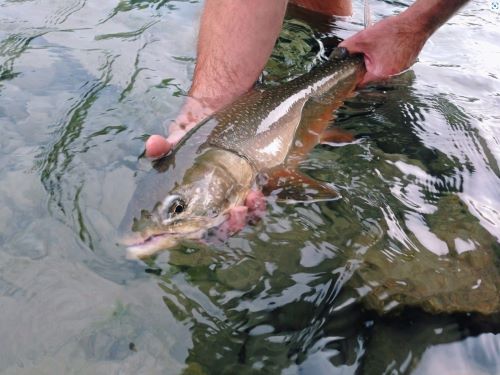Bull trout, a piscivorous member of the char family, are a favourite amongst fly anglers due to their habitat, size, and beauty.
How to identify bull trout
There are several characteristics of the char family that are unique relative to other trout, including the light spots on a dark body (unlike rainbow trout or cutthroat, which have dark spots on a light body), cream-white leading edges on the lower fins, and teeth on the roof of the mouth (also called a “vomer”), which are used to grip larger prey.

While all char are revered for their colours and patterns, bull trout are distinctive owing to the spotting pattern that runs along each side of their body. These spots show up in hues of white, pink, red, or even lavender. They are usually contrasted against a charcoal-blue or gunmetal-grey body colour.
Bull trout behaviour changes through the seasons
What truly sets these fish apart from their aquatic cohorts in my fly-fishing pursuits has been to witness the fascinating changes they undergo throughout the shifting seasons. In the early season, which for Classified Waters in Region 4 is June 15th, these fish are silver bullets – aggressive, scrappy fighters with insatiable appetites. They are notorious for dramatic displays of chasing (or even eating) cutties fighting at the end of your line. Fly anglers target these fish-eating carnivores using large streamer and intruder patterns, often in white, olive, purple, and black (anything tied with white rabbit and a silver cone head is my go-to). Some of the spunkier fish will take a stonefly nymph, or even rise to a dry fly. But as the season winds on, and the heat of summer peaks and then falls, these fish begin to dramatically transform their appearance – and their behaviours, too.

Almost as if following the autumn leaves, bull trout start colouring up from late August into the fall. Their white bellies turn shades of sunflower-yellow and cherry-red; their charcoal-blue flanks turn brassy-olive, and mature males develop hooked jaws, or kypes. They can become less aggressive, even lethargic, and due to the abundance of large prey around, tend to gorge only in periodic meals. Due to the fall kokanee runs that coincide, they can be more difficult to target around this time due to the abundance of large prey around. Eventually, their feeding patterns slow to a near halt, and the priority of passing on genes takes over. This is all in preparation for their fall spawning period – another behaviour that separates these char from other spring-spawning trout.

Anadromous and Interior populations
Bull trout appear in numerous forms, including a coastal anadromous population, and the aforementioned interior populations. In the southeast corner of B.C., interior fish can be found in crystalline mountain streams and lakes, both as residents or migratory trout. They prefer to hold in the deepest, slowest moving sections of a stream, typically the tail-out of a pool. To get the most out of a pool, an angler would fish dry flies on light tippet at the top through to the middle for cutties, and swing streamers from the middle through to the tail-out for bullies. It is in these spots that they can drift slowly across the currents, snapping big jaws at anything that crosses their snout, and hopefully, that includes your streamer.

A bull trout’s aggressive feeding behaviour can be attributed in part to living in waters where its food sources are relatively scarce. As a species of special concern, their willingness to strike flies leaves them vulnerable to overfishing; it can take up to 20 years for populations to recover. Be sure to read the freshwater fishing regulations concerning bull trout. Whenever possible, practice catch-and-release, and voluntarily limit your harvest.
Author: Jen Dunphy
Photo Credit: Jen Dunphy, Cathy Fiedler & Cliff Razzo
Jen spends her winters swinging streamers for steelhead on Vancouver Island, and her summers casting dry flies for trout in the Rocky Mountains. Follow Jen on Instagram.
